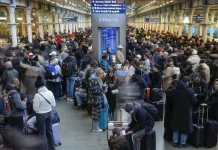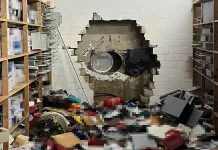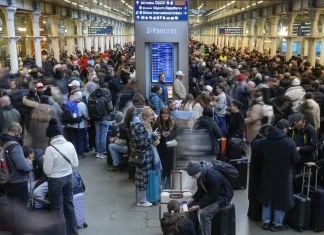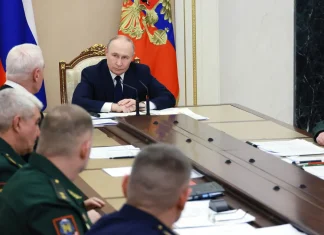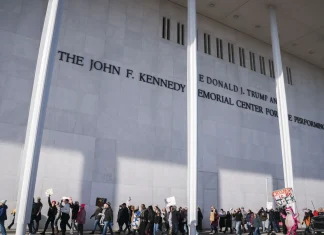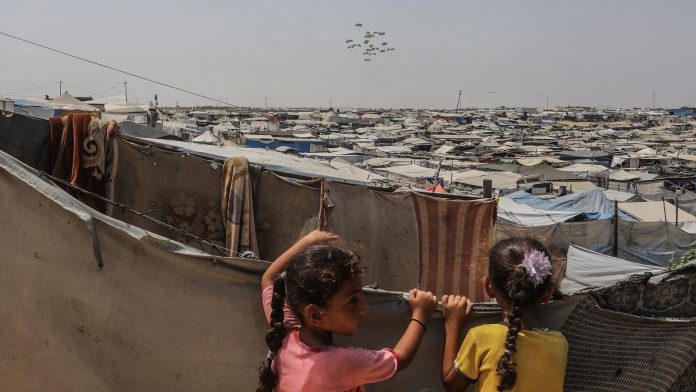
In Gaza’s Shadow: A Day Amid the Devastation and Desperation
Imagine standing in a crowded square where hope and fear intertwine like an unrelenting storm. The air thick with dust from crumbled buildings and the hum of anxious voices, all waiting—for food, for safety, for a sign that the world has not forgotten them. This is the heart of Gaza today, a place where devastating conflict has become the cruel backdrop of daily existence.
Tragedy Near Aid Stations: Innocence Targeted
On a day like many others since May, thousands of Palestinians gathered near aid distribution points scattered across Gaza, hoping to receive essential supplies. Yet, what should have been a humanitarian gesture was shattered by tragedy. According to Mahmud Bassal, a spokesman for Gaza’s civil defence agency, Israeli military strikes struck civilians assembling by an aid point in central Gaza, killing at least six and wounding 30.
Among these mournful scenes, families who had queued patiently for food were caught in crossfire. Bassal detailed another harrowing attack—a drone strike near Khan Younis in southern Gaza that claimed at least three more lives and injured several others. It is a grim reminder: for many in Gaza, even seeking help carries mortal risk.
“We were waiting for bread and water,” recounts Fatima, a mother of three from Gaza City, her voice quivering as she clutches a worn-out bag. “Suddenly, the drones appeared. There was chaos, screams, dust everywhere. Nobody was safe, no one expected help would turn to harm.”
Humanitarian Lifelines Strangled
Since the war’s escalation nearly two years ago, Israeli-imposed restrictions on Gaza’s borders have strangled the flow of food, medicine, and fuel. Hospitals, utterly reliant on fuel for their generators, hover on the brink of collapse as supplies dwindle. According to the UN, roughly 2.3 million Gazans face increasing hunger and medical emergencies daily—numbers that defy comprehension yet tell a stark truth: the humanitarian crisis in Gaza is spiraling out of control.
At four major distribution centers, including those overseen by the Gaza Humanitarian Foundation, thousands brave long lines and tense conditions just to receive what many in more stable regions take for granted. Each visit is a gamble, and every day brings a fresh report of injuries or deaths from stray strikes.
“We live on a knife’s edge,” says Dr. Samir Hussein, an independent health analyst based in Amman. “When aid becomes a target, it is not merely a failure of strategy—it is a breakdown of humanity.”
Netanyahu’s Defiant March and Global Outcry
For Prime Minister Benjamin Netanyahu, domestic and international pressures mount with every passing day. On one hand, there is intense global demand for a ceasefire, urged by humanitarian groups, governments, and diaspora communities alike. On the other, a looming militant hostage crisis and security concerns push Israeli policy further into aggressive military action.
Just this week, Netanyahu’s security cabinet approved plans for an expansive operation to seize Gaza City. Netanyahu himself framed the offensive not as occupation, but as “liberation from Hamas.”
“We are not going to occupy Gaza,” Netanyahu declared on social media. “We are going to free Gaza from Hamas.”
A statement that sparked outrage and deepened unease worldwide. Hamas branded the plan a “new war crime,” while international lawmakers and human rights organizations warned of escalating civilian casualties. Many question: can military might ever truly “free” a people already under siege?
The Human Toll: Numbers Beyond Numbers
The human cost is staggering. The UN supports data from Gaza’s health ministry, which estimates that over 61,000 Palestinians have died since hostilities intensified following Hamas’s October 7, 2023, attack on Israel. By contrast, videos and official tallies record 1,219 Israelis killed in that initial assault.
Numbers, however, never capture the full horror. Listen to the story of Amir— a young teacher who lost his entire family in an airstrike that leveled his neighborhood in Gaza City. “I see only rubble where a home and childhood once were,” he says. “Numbers cannot tell you about the silence after the screams.”
The Fractured Palestinian Landscape
Complicating the crisis is the intricate political landscape. The Palestinian Authority (PA), which controls parts of the West Bank but not Gaza, has publicly condemned the Israeli escalation. Nabil Abu Rudeineh, the PA’s spokesman, called on the international community—especially the UN Security Council—to demand an immediate end to the aggression and facilitate aid access.
“This government’s actions are an unprecedented challenge to peace,” Abu Rudeineh said. “They provoke the international will and threaten the fragile hopes of stability in this region.”
Meanwhile, Gaza remains governed by Hamas, which has held control since 2007, further complicating both aid efforts and political resolutions. The broader West Bank sees around 3 million Palestinians and approximately half a million Israeli settlers, the latter in settlements deemed illegal by much of the international community.
Reflections From the Ground and Beyond
Walking through Gaza in these times is to witness not just the ruins of a city, but the resilience of a people clinging to life and dignity amid relentless catastrophe. Street vendors whisper of better days; children draw amid rubble, their chalk outlines a stark contrast to concrete destruction.
“We want peace,” says Leila, an elderly woman tending a small vegetable garden amidst the chaos. “Not just for us, but for future generations. We just want to live without fear.”
Her words echo a universal truth that transcends borders: the longing for safety, nourishment, and hope. The world watches Gaza—too often as a statistic, too rarely as a community full of stories, scars, dreams, and heartbreak.
Where Do We Go From Here?
As you read this, hundreds more may be lining up near aid stations, unsure if relief will come or if danger might strike again. How should we respond as global citizens? What responsibilities do those far from the conflict hold toward those inevitably caught in its crossfire?
Perhaps it starts with remembering the humanity behind the headlines—the neighbors, the parents, the children whose futures hang precariously in the balance. What would you do if a simple visit to get food endangered your life? If the walls of your home crumbled while the world debated strategies and statistics?
In this panoramic tragedy, Gaza is not just a place on a map—it is a mirror reflecting questions of morality, justice, and the cost of conflict that we cannot, must not, ignore.


